Spring! During April, I’ve joined once-a-week activity of Lovers of Niiharu. Every weekend morning, the same route, but the different scenery. First the pale pinks and whites of cherry blossoms over there, then the forest became pale green, a bit brighter green, bright pink of peaches, brilliant yellow of kerria japonicas … the burst of colors everywhere! The air is clean and Niiharu changes its hues every weekend. Spring has come!
So, it’s fit to have a volunteer training class this time of the year in Niiharu. In the middle of April, the city of Yokohama held the annual spring one-day training class for registered volunteers. The title, “30 Spring Flowers in the Forests of Yokohama, for beginners.” (In this post, the photos of flowers with “#” are in the list.) The instructor was Ms. Yoshiko Kitagawa, a former botanist for University of Tokyo, who was born in Yokohama and knew the ecology of Niiharu inside-out. Ms. Kitagawa was assisted by another botanist, Ms. Ookuma, who is studying Niiharu since 1990. The ladies were like veteran spring fairies who were so familiar with Niiharu Forest. Ms. Kitagawa was one of the members who drafted the Yokohama Citizen Forestry Guideline and Conservation /Management Plan 横浜市森づくりガイドラインと保全管理計画.
 |
| A crab
is also living in Niiharu. Could you see, it’s in the middle, under the log? |
The structure of the class was similar to that for the birds in February. First, in Okutsu House, we had a lecture about ecology of forests in Yokohama, then Ms. Kitagawa introduced us how to “read” the feature of plants to identify each with forms of flowers, leaves, etc. After this quick “plant observation 101” (and lunch), we went into Niiharu Forest to learn the actual plants in situ. About 3 hours of walk for plants, and then we returned to Okutsu House to review our observation. I didn’t know the difference between monoplane and compound leaf, and the usefulness to know such anatomy of plants to distinguish them in the wild. … I’m a so ignorant city rat …
 |
| Calanthe
Discolor, near threatened species, at the gate of Okutsu House in April. Of course, it’s not wild. |
Ms. Kitagawa said last year she surveyed 20 ha ag lands in Tochigi Prefecture, and found 450 kinds of plants. In contrast, about 2,000 m2 of Asahi Yato in Niiharu has at least 300 varieties. This is something. Though, the situation is still critical … According to Ms Kitagawa, reviewing scientific records since the mid 19th century we know Yokohama has had 2,052 kinds of plants. As of 2001, 594 of them are extinct / near-extinct, and 677 are alien, and quite often invasive, species. Take dandelion. Niiharu has 3 kinds of dandelions. One is native Kanto dandelions. Another is white dandelions which are a cousin of Kanto dandelions brought in at the middle of the last century by a bride who came from Kyushu for one of the landlords (; Kyushu’s native dandelion is white … I’m praying for Kumamoto now). The third one is ferociously invasive European dandelions which are expanding their territory at the expense of natives. The reason is simple. Kanto dandelions are easygoing local bunch, which flower only once in spring. They need another plant to produce seeds that require spending a hot summer of Japan dormant and sprout in autumn. In contrast, vigorous Europeans found Japanese climate warmer than their native land, and comfortable to flower continuously for more than 6 months. In addition, they do not need another plant to bear effective seeds that sprout immediately after they find a soil to settle. Before babies of Kanto dandelions begin their life, the game is over. The land is taken by the Europeans. Yokohama is an international port city, often a first gate of entry. Similar stories are happening for the other species, Ms. Kitagawa said.
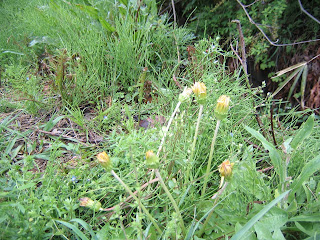 |
| In
Niiharu. Kanto dandelions (taraxacum platycarpum; #6) whose involucre is curling in. |
 |
| In
Niiharu. European dandelions (taraxacum officinale) whose involucre is warping outside. |
 |
| In Niiharu. White dandelions (taraxacum albidum). |
I first thought it may be a regular xenophobic thing in Japan. But Ms. Kitagawa’s logic made sense to me. She said these days when she went to the other Asian countries, especially hotter places like Indian Subcontinent, ASEAN cities, or mega-cities in southern China, she found the vegetation is becoming more and more uniform. The biodiversity is decreasing region-wide. Japan could take the same route if we let aliens occupy the land. Those countries in the north, like the UK, had originally small biodiversity so that warmer climate makes them able to host “exotic” fauna and flora, AND their biodiversity increases at least numerically. They can say their land is open for “foreigners.” Japan is different. It’s an archipelago with a unique and very diverse local ecology. If we allow our environment to be identical to the “world standard,” maybe Shanghai?, the math for the biodiversity of the earth yields smaller number of fauna and flora in the entire planet. It is a loss, and so Japan is in color red at the site of Conservation International. More protection efforts required.
 |
| A
colony of Delphinium anthriscifolium in Niiharu. It was first introduced from China to Koishikawa Botanical Garden of Tokyo University in the 19th century. It escaped from the “cage,” and is now spreading around Tokyo, expelling locals like Corydalis incisa. |
 |
| In Niiharu. Corydalis incisa (#27). |
 |
| Euphorbia
helioscopia at the edge of Niiharu Forest. Well, certainly, the road is easy to walk now thanks to the paving … |
 |
| In
Niiharu. Lilium auratum, prefectural flower for Kanagawa, and Polygonatum odoratum (angular Solomon’s seal, #2). |
When Satoyama was a field for subsistence rice agriculture, the ecology of Niiharu was sustained by regular maintenance jobs by farmers. The roads criss-crossed Yato-da rice paddies were hand-mowed max 5 times from April to October so that the height of the typical plants was short, like Mazus miquelii. Though, it was the place only farmers used. The soil was not compacted … Now, nostalgic city dwellers walk the road heavily, which makes the soil difficult for the plants to sprout … Before, the community had a tacit consent to cut trees and grass on slopes surrounding Yato-da paddies without the consent of the landlords. Normally, this job was done twice a year before rice planting in late spring and rice harvesting early fall, in order to make the space for the planting and harvesting tasks. It let the area around the Yato-da paddies forest edge with lots of sunshine and air circulation where varieties of plants, tall and short, thrived.
 |
| Could
you figure out the difference in the height of grasses on the banks of the paddies, and slopes surrounding Asahi-yato? |
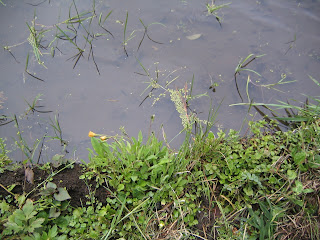 |
| In
Niiharu. Lxeris japonica (#5) and Mazus miquelii (#28). |
 |
| In
Niiharu. Euphorbia sieboldiana (#18) on the slope around Yato-da paddies. |
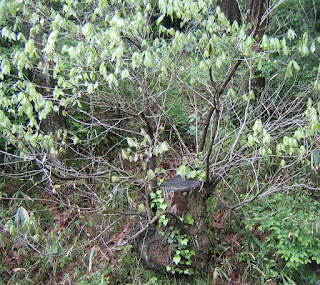 |
| In
Niiharu. This coppiced Quercus acutissima is ready for choosing the most vigorous sucker. |
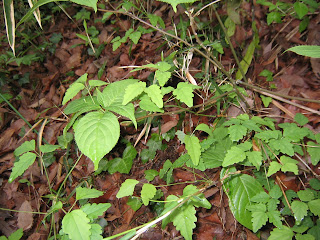 |
| In Niiharu. Female of Helwingia japonica (#21). |
 |
| In Niiharu. Male of Helwingia japonica (#21). |
Here is the list of 30 Spring Flowers
for the class. We could find all of them in Niiharu of one April afternoon.
They are indicator species we volunteers should watch … phew!
#1 Viola phalacrocarpa
#2 Polygonatum odoratum (angular
Solomon’s seal)
#3 Polystichum polyblepharum
#4 Lonicera gracilipes var. glabru
#5 Lxeris japonica
#7 Potentilla fragarioides var. major
#8 Lycoris sanguinea
#9 Stachyurus praecox
#10 Ajuga decumbens
#11 Ranunculus cantoniensis
#12 Rubus hirsutus
#13
Chaenomeles japonica
#14 Cymbidium goeringii
#15 Viola grypoceras
#16 Viola verecunda A. Gray
#17 Valeriana flaccidissima
#18 Euphorbia sieboldiana
#19 Anemone flaccida
#20 Cirsium japonicum
#21 Helwingia japonica
#22 Disporum sessile
#23 Lithospermum zollingeri
#24 Viola phalacrocarpa
#25 Staphylea bumalda DC.
#26 Polygonatum lasianthum
#27 Corydalis incisa
#28 Mazus miquelii
#29 Rubus palmatus var. coptophyllus
#30 Arachniodes standishii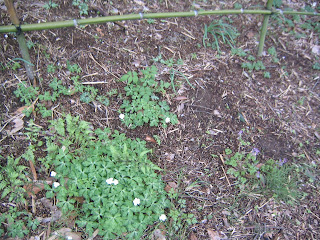 |
| By the
way, Anemone flaccida (#19) have come out a lot in the place where we mowed Sasaella ramose last fall during the Forest Volunteering 101. Yayyyyyy! |
If you find a
problem in the Niiharu Forest, please make a contact with
Office for the Park Greeneries in the
North 北部公園緑地事務所
Yokohama Municipal Government
Creative Environment Policy Bureau 横浜市環境創造局
Phone: 045-311-2016 (I guess in
Japanese only)
FAX: 045-316-8420 (I hope there is
somebody who can read English …)
Niiharu Administrative Office /
Satoyama Exchange Center 新治管理事務所・里山交流センター
Phone: 045-931-4947
Fax: 045-937-0898
http://www.niiharu.jp/




No comments:
Post a Comment